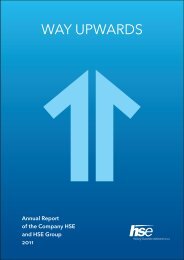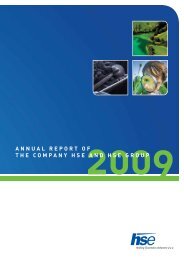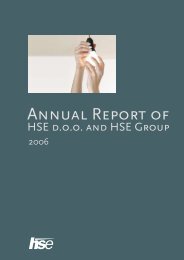ANNUAL REPORT - HSE
ANNUAL REPORT - HSE
ANNUAL REPORT - HSE
You also want an ePaper? Increase the reach of your titles
YUMPU automatically turns print PDFs into web optimized ePapers that Google loves.
holding an investment, investments are recorded as<br />
long-term or current assets in the balance sheet.<br />
Inventories<br />
Inventories, being part of the company's current assets,<br />
are initially recognised at cost, which comprises<br />
their purchase price, import duties and other nonrefundable<br />
purchase taxes, as well as direct costs of<br />
purchasing. The purchase price is decreased by the<br />
discounts obtained.<br />
The carrying amount of an item of cash equals its initial<br />
nominal value, which can change due to changes<br />
in foreign exchange rates if cash is denominated in<br />
foreign currencies.<br />
Short-term accrued<br />
revenue and deferred costs<br />
Short-term accrued revenue and deferred cost items<br />
comprise short-term deferred costs and short-term<br />
accrued revenue.<br />
If the prices of the items that are purchased anew<br />
in the accounting period differ from the prices of inventory<br />
items of the same class, the first-in first-out<br />
(FIFO) method is applied to decrease the quantities of<br />
inventories during the year.<br />
Receivables<br />
The company’s assets include receivables as the rights<br />
arising from property and other legal relationships to<br />
demand the settlement of a debt or delivery of items or<br />
services from a specific person. All receivables are initially<br />
recognised at amounts recorded in relevant documents<br />
on the assumption that they will be collected.<br />
In the balance sheet, receivables are disclosed in their<br />
net amounts, meaning they are reduced by any allowances<br />
for disputed and doubtful receivables. The allowances<br />
for receivables are made on an individual<br />
basis. If receivables are not collected in a certain period,<br />
they are considered doubtful. If legal proceedings<br />
have been initiated in relation to them, they are<br />
considered disputed.<br />
Receivables of smaller values are written off based on<br />
a management's decision if it is determined that the<br />
costs of collection of such overdue receivables exceed<br />
the amount of the receivables, making a further collection<br />
economically unviable.<br />
Depending on their maturity, receivables are carried<br />
as long-term or current assets in the balance sheet.<br />
Cash<br />
Cash represents deposit money, i.e. cash in bank accounts<br />
that can be used for payments. It comprises<br />
cash in accounts and cash available at notice.<br />
Short-term deferred costs include amounts incurred<br />
but not yet charged against the company's profit or<br />
loss.<br />
Short-term accrued revenue represents amounts that<br />
have been included in profit or loss but have not yet<br />
been charged.<br />
Equity<br />
Total equity is defined by the amounts invested by<br />
owners and the amounts generated during operation<br />
and belonging to the owners.<br />
Nominal capital is carried in the national currency.<br />
Nominal capital and capital surplus represent owner’s<br />
cash contributions and contributions in kind.<br />
Other revenue reserves are set aside on the basis of<br />
decisions adopted by the Supervisory Board and the<br />
General Meeting.<br />
Net profit or loss represents the undistributed portion<br />
of the company's net profit or loss for the current<br />
year.<br />
Revaluation surplus includes the value of hedging derivatives.<br />
Provisions and long-term accrued<br />
costs and deferred revenue<br />
Provisions are created for obligations that are expected<br />
to arise from obligating past events in the coming<br />
periods and the value of which is based on the estimated<br />
present value of expenses that are expected to<br />
be required to settle such obligations. The amount of<br />
provisions for jubilee benefits and termination ben-<br />
<strong>ANNUAL</strong> <strong>REPORT</strong> <strong>HSE</strong> | FINANCIAL <strong>REPORT</strong> OF THE COMPANY <strong>HSE</strong><br />
101



